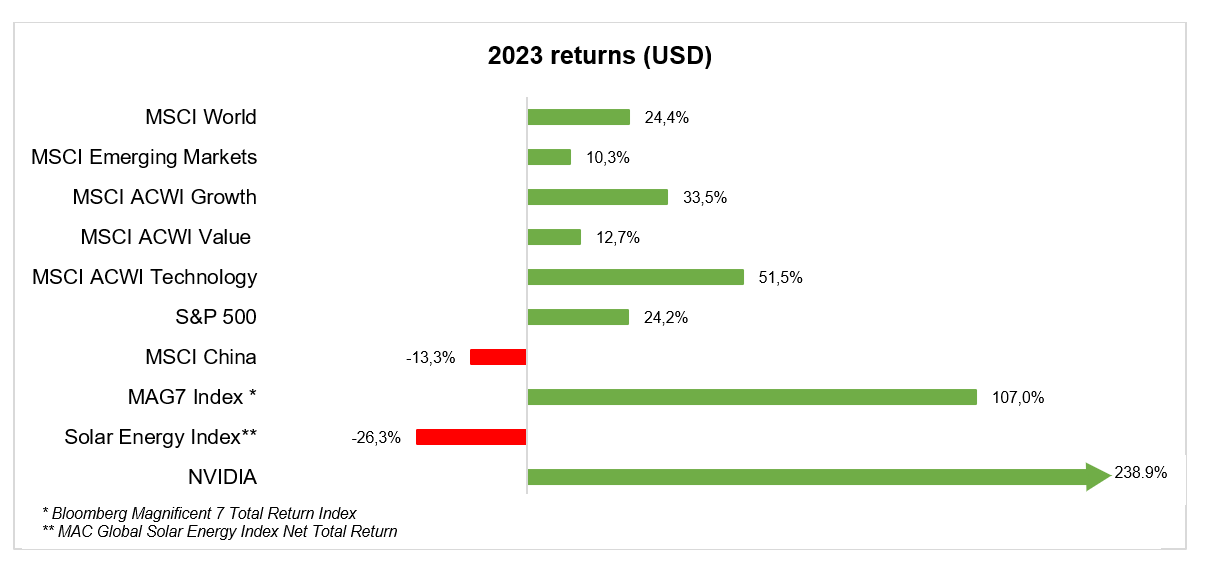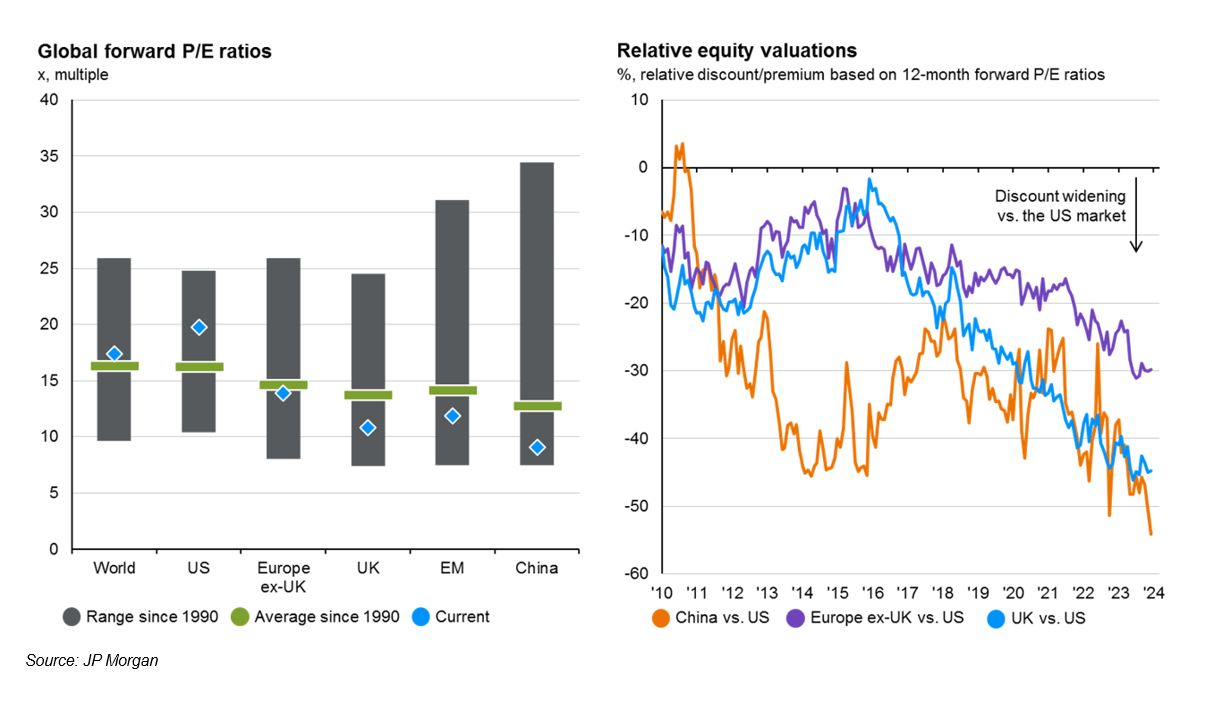Risk appetite recovered strongly as falling inflation data spurred hope among investors that interest rates have peaked, something all but confirmed when Jay Powell surprisingly announced that US borrowing costs would fall in 2024. Record amounts of capital flowed into equities and the ‘everything rally’ saw sharp recoveries in areas of the market that had previously been ignored like commercial real estate and regional banks as fears of an economic hard landing subsided.
This unlikely Goldilocks scenario helped global equities to close 2023 up 23% and deliver the best calendar year return since 2019[1]. As has been widely reported, the ‘Magnificent Seven’ did most of the heavy lifting, propelling the US S&P 500 index (of which Alphabet, Amazon, Apple, Meta, Microsoft, Nvidia and Tesla now represent 30%) to new highs while the Nasdaq 100 index of large tech stocks had its best year since the dotcom bubble burst, rising by more than 50%.
On a sector level, the MAG-7’s dominance helped Technology (+52%) top the charts, followed by Communication Services (+38%) and Consumer Discretionary (+30%), while more defensive areas such as Energy (+6%), Consumer Staples (+3%) and Utilities (+1%) struggled to eke out returns as growth (+34%) comfortably beat value (+13%) over the year[2].
Their strength also saw developed markets (+24%) outperform emerging ones (+10%) with the latter impeded by China (-13%) where regulatory uncertainty and a property collapse has eroded investor confidence. Indeed, real estate globally had a tough year as higher interest rates created funding challenges while falling occupancy levels and sales volumes put downward pressure on asset values.

Strong fund performance
Against these market headwinds, I am pleased to report that all of our funds delivered strong absolute returns and the majority beat their benchmarks over the year. SKAGEN Kon-Tiki outperformed despite being underweight the best performing emerging markets of India and Taiwan, largely due to excellent stock picking in weak Chinese and South Korean markets – the fund’s fourth consecutive calendar year of positive relative returns.
SKAGEN Focus triumphed over the MSCI All Country World Index despite holding none of the MAG-7, thanks to three of its holdings being bought out at substantial premiums in the fourth quarter as record valuation discounts have sparked merger mania among small and mid-caps. M&A activity also boosted our third relative winner, SKAGEN m2, whose largest holding was taken private at a huge premium after spending several years in the portfolio – a reward for good stock picking and patience.
SKAGEN Global delivered strong absolute returns, particularly in the final quarter as the market began to acknowledge the value in many of its holdings, but unfortunately the momentum was insufficient to close the gap behind the index for the year. SKAGEN Vekst similarly delivered impressive absolute returns but lagged its benchmark due to its lower weighting in large US tech stocks.
You can read the funds’ year-end appraisals in their fourth quarter reports. Given our longer-term investment horizon, it is particularly satisfying that four out of five closed entered the new year ahead of their benchmarks over three or five years.
Focus on fundamentals
I believe taking a long-term view will be particularly important in 2024. Stock markets have already been bumpy in the opening few weeks as inflation data has disappointed and the Middle East conflict has escalated. Geopolitical risks were a red thread running through our New Year Conference and voted the biggest threat to capital markets in 2024 by audience members. With much of the world going to the polls in 2024, including the US where the election outcome could be very close, there will inevitably be further turbulence ahead.
As with the war in Ukraine, the market has so far largely shrugged-off the terrible events in Israel and Gaza. However, the inflationary impact from the conflict now spilling-over into shipping attacks in the Red Sea again highlights the fragility of both global supply chains and hopes for a soft economic landing.
Until now investors’ belief that inflation is under control has been largely unshaken with five US interest rate cuts still expected this year and the first odds-on to happen in March according to Bloomberg. A more benign macro backdrop would certainly be supportive for stock pickers and our hope is for equity performance to be influenced less by economic factors in 2024 with more focus on company earnings and fundamentals. However, with data in the new year showing how sticky inflation can be, particularly in the final push towards central banks’ targets, this may be wishful thinking.
A postscript to the year-end rally is that valuations in developed markets are now above historic averages, particularly in the US where headline multiples are skewed by the MAG-7. In Europe (notably the UK) and emerging markets (notably China) valuations remain well below 30-year averages, while their relative discounts to US equities are at record highs and continue to grow. A benefit of bottom-up investing is that even in the US, where 70% of stocks underperformed the index last year and roughly a third actually fell in price, there is value to be found.

The bubbling valuations at the top, however, increasingly threaten the US market overall and the broader indices of which it represents an increasingly large chunk. I have written previously about the concentration risk faced by passive investors and it suffices to say that this is now so big that a negative re-rating among the MAG-7 could spark a wider correction. Time will tell whether bigger really is better or if, as I suspect, smaller is smarter.
If consensus is correct about inflation and interest rates peaking, the dollar weakening and slower relative US growth, investors should also consider a higher allocation to emerging market equities. A new era of pro-growth monetary policies (some major EM central banks have already pivoted), combined with knock-down valuations and an expected recovery in earnings this year would be supportive for positive relative and absolute returns.
With stock markets likely to remain bumpy this year, my final piece of advice is to stay invested and diversified. The ten best days of 2023 contributed three quarters of the S&P 500’s total 24% return and recent history[3] shows that the best days often occur soon after the worst. Timing the market is much harder than building a diversified long-term portfolio and likely to be far less lucrative. I hope you will join us for what promises to be another eventful year of stock picking in global stock markets, and I look forward to updating you on our progress.
[1] Source: MSCI: MSCI ACWI in USD.
[2] Source: MSCI in USD.
[3] Source: JP Morgan.




